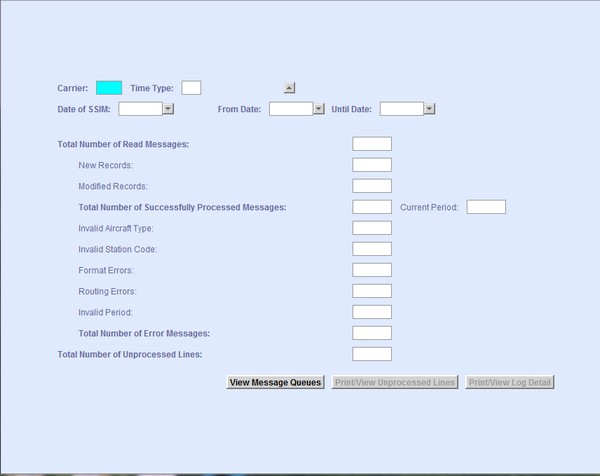The SSIM Log
The SSIM Log can be viewed in or automatically upon processing a Standard Schedules Information message (SSIM). You need the appropriate duty code and be logged on at the HDQ station to access the SSIM Log screen.

- display a particular SSIM file if all its details are known
- search for processed SSIM files
| Field | Description |
|---|---|
| Carrier | The IATA two-character Carrier code. |
| Time Type | Displays the time of the Standard Schedule Information message (SSIM), which is either Local or Coordinated Universal Time (UTC). If a time code is not found in the appropriate position in the SSIM header line 2, the system defaults to UTC. |
| Operator Code | The operator code of the user who initiated processing of the SSIM. |
| Date of SSIM | The date of the SSIM taken from the header line 2. |
| From Date | The date from which the operating period (the schedule) begins taken from the header line 2. |
| Until Date | The date at which the operating period (the schedule) ends taken from the header line 2. |
| Total Number of Read Messages | The total number of Standard Schedule Message (SSM) messages the system has read from the SSIM. |
| New Records | The total number of new records (flight records) the system has created. |
| Modified Records |
The total number of flight records which have been modified. The following SSM
status codes are handled by the system:
The following SSM status codes are not handled by the system:
|
| Total Number of Successfully Processed Messages | The total number of successfully processed messages. |
| Current Period | When configured, the Standard Schedules Messages (SSM)/Ad-Hoc Schedule Messages (ASM) that fall within the current period are placed on the current period queue. The total SSM/ASM that fall within the current period. |
| Invalid Aircraft Type | When configured, Standard Schedules Messages (SSM)/Ad-Hoc Schedule Messages (ASM)
which refer to an aircraft type not present in the system are placed on the Invalid
Aircraft type queue. For this error, the aircraft has to be properly created in the system before resending the message. |
| Invalid Station Code | When configured, Standard Schedules Messages (SSM)/Ad-Hoc Schedule Messages (ASM)
which refer to station or airport codes not present in the system are placed on the
queue. The station or airport code has to be properly created in the system before resending the message. |
| Format Errors | When configured, Standard Schedules Messages (SSM)/Ad-Hoc Schedule Messages (ASM) with formatting errors are placed on the queue. The number of SSM/ASM with this type of error in the processed SSIM is displayed in this field. |
| Routing Errors | When configured, Standard Schedules Messages (SSM)/Ad-Hoc Schedule Messages (ASM) with invalid routing are placed on the queue. The number of SSM/ASM with this type of error in the processed SSIM is displayed in this field. |
| Invalid Period | When configured, Standard Schedules Messages (SSM)/Ad-Hoc Schedule Messages (ASM) with invalid period are placed on the queue. The number of SSM/ASM with this type of error in the processed SSIM is displayed in this field. |
| Total Number of Error Messages | The total number of all the error messages. |
| Total Number of Unprocessed Lines | The total number of unprocessed SSIM lines. |
| View Message Queues | Use this button to navigate to the Message Queue. Clicking View Message Queues shows the current state of the queues, not the state of the queues at the time of processing the currently selected SSIM file. This means that if the queue messages that were associated with the selected SSIM file have been deleted, then the messages from that SSIM file will not be displayed in the appropriate queue in the Message Queue. |
| Print/View Unprocessed Lines | Use this button to print or view the unprocessed lines. Lines which do not conform to the specifications defined in the Standard Schedules Information (SSIM) Manual are not processed. The system moves on to the next line it finds which does conform to standard. These lines that are not processed are captured and can be viewed by selecting the Print/View Unprocessed Lines button. It is not possible to amend or resend these lines from the viewing screen. |
| Print/View Log Detail | Use this button to print or view the SSIM summary log. |